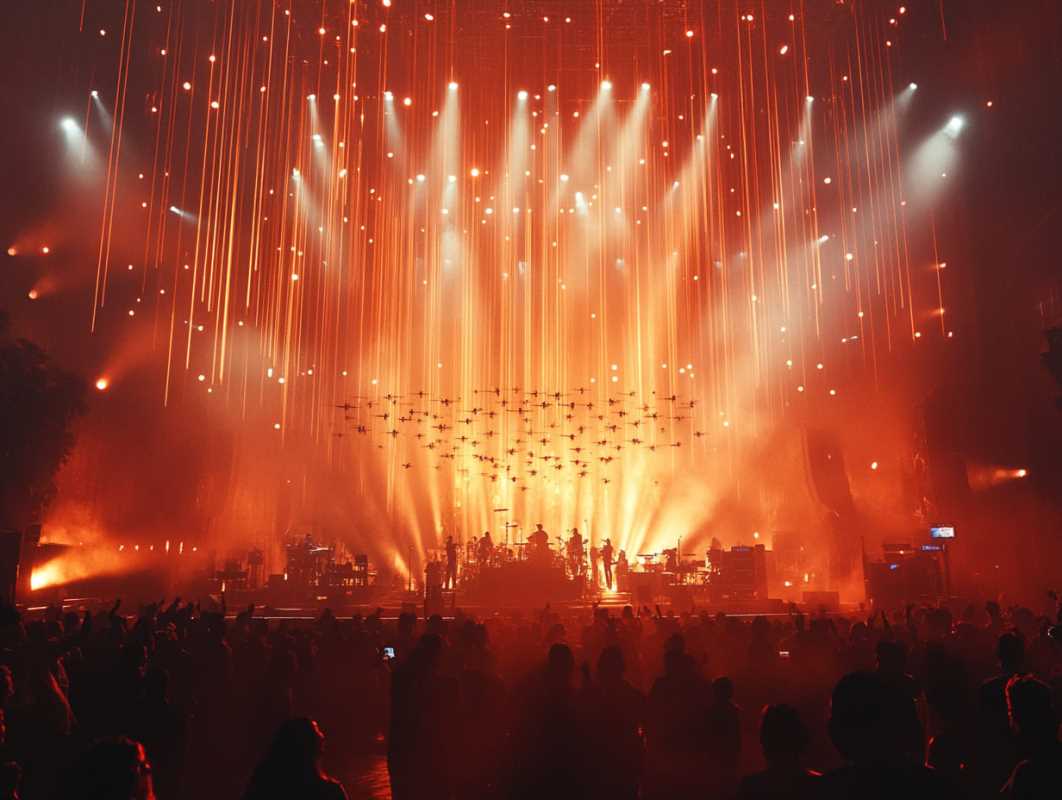Drone technology has advanced dramatically over the past decade, growing from its roots as a hobbyist pastime into a cornerstone of innovation across industries. One of the most exciting applications of drone technology is in large-scale events, where drone swarms are redefining the boundaries of spectacle, logistics, and storytelling. Whether lighting up the night sky with breathtaking visuals or streamlining operations on the ground, drone swarms are revolutionizing how we experience and manage grand gatherings.
Transforming the Art of Visual Spectacles
When people think of large-scale events, one of the first images that comes to mind is the iconic firework display — a timeless tradition for celebrations and milestones. However, drone swarms are not only challenging this age-old medium but are emerging as its futuristic successor. With thousands of synchronized drones equipped with LED lights, the night sky becomes a programmable canvas for artistic and dynamic visuals.
Drone light shows have captivated audiences worldwide, from halftime shows to Olympic ceremonies. Unlike fireworks, which burn out in moments and leave behind smoke and debris, drones are reusable, programmable, and environmentally friendly. Their versatility allows them to:
- Create 3D imagery, such as rotating globes or dancing animals, visible from all angles.
- Incorporate live storytelling by displaying text, symbols, and even facial expressions in the air.
- Sync visuals with music and soundscapes, creating an immersive multimedia experience.
- Reduce safety risks, as drones operate under precise controls and pose minimal hazard when well-managed.
- Scale performances effortlessly, from intimate gatherings to global events.
One stunning example was during the 2018 Winter Olympics in PyeongChang, South Korea, where 1,218 drones formed a sparkling snowboarder carving through the sky. It was a moment that showcased the limitless creativity drones can bring to events, enchanting millions of viewers.
Enhancing Event Logistics and Operations
While the visual dazzle of drone swarms tends to steal the spotlight, their behind-the-scenes applications are no less revolutionary. Managing a large-scale event is an intricate operation that involves crowd control, security, transportation, and communication. Drones are emerging as indispensable tools to streamline these tasks efficiently and intelligently.
Equipped with cameras, thermal imaging, and GPS, drones can provide real-time monitoring over vast areas. In high-stakes environments like music festivals or marathons, drones aid in several ways:
- Overhead surveillance to ensure crowd safety, identifying potential bottlenecks or hazards.
- Rapid delivery of supplies such as first-aid kits or water bottles in emergencies.
- Detailed mapping of event venues, allowing organizers to plan better layouts.
- Communication relays to enhance connectivity in remote or crowded areas.
- Aerial lighting to illuminate sections of the venue in real time, reducing the need for extensive ground lighting rigs.
For instance, at the Glastonbury Festival in the UK, drones have been employed for real-time crowd monitoring, aiding in reducing congestion and ensuring a smooth flow of attendees. Similarly, drones used at marathons deliver medical kits to runners in distress faster than traditional methods.
These capabilities not only save time and labor costs but also significantly enhance the safety and experience of event participants. The prospect of fully autonomous drones capable of advanced decision-making adds another layer of potential to these logistical applications.
Where Technology Meets Artistry
Drone swarms aren’t just tools; they are a medium for breathtaking artistic expression. The collaboration between engineers, choreographers, and artists has birthed an entirely new genre of performance art where technology and creativity merge. Designing a drone performance is an intricate process that balances precision programming with imaginative storytelling, resulting in mesmerizing displays.
One of the most notable moments in drone artistry was the 2020 Tokyo Olympics, where 1,824 drones created a luminous globe hovering over the stadium. It symbolized unity and global solidarity in a year fraught with isolation. Similarly, brands like Intel have showcased drone artistry at events like the Super Bowl and the Coachella music festival, turning the sky into a theater of light.
The artistic potential of drone swarms lies in their adaptability. Each drone in a swarm is a pixel in the sky, and with thousands of “pixels,” artists can create animations, patterns, and scenes that resonate deeply with audiences. They are a storytelling device, a digital sculpture, and a cultural moment all rolled into one.
Drones also have the unique ability to interact with other elements of a performance. They can sync seamlessly with stage lights, pyrotechnics, and even performers on the ground, creating multi-layered experiences that were unimaginable just a decade ago.
Overcoming Challenges in Drone Swarm Events
Despite their potential, using drone swarms at large-scale events comes with significant challenges that organizers must navigate. Environmental factors, technical limitations, and regulatory hurdles all play a role in shaping the feasibility and success of drone operations.
Environmental Factors
Drones are vulnerable to weather conditions such as strong winds, rain, or snow. These factors can disrupt flight paths or damage equipment. Event planners must monitor weather forecasts closely and have contingency plans in place.
Technical Challenges
Battery life remains a constraint for drone performances. Most drones can only stay airborne for 20-30 minutes, requiring careful planning and execution. Additionally, collision-avoidance systems are critical when operating dense swarms, especially in crowded environments.
Regulatory and Safety Concerns
Public safety is paramount when deploying swarms of flying devices in open spaces. Governments worldwide are still developing frameworks for safe and legal drone usage at events. Compliance with airspace restrictions, privacy laws, and safety protocols is mandatory, requiring close collaboration with aviation authorities.
Advancements in technology, such as better battery efficiency and AI-driven flight management, are gradually mitigating these issues, making drone swarms more reliable and accessible for event planners.
The Expanding Horizon of Drone Swarms in Events
The integration of drone swarms into large-scale events is only the beginning. As technology advances, new possibilities are emerging that promise to make these aerial marvels even more impactful.
Future Trends and Innovations
One exciting trend is the use of AI to make drone swarms smarter and more autonomous. AI algorithms allow drones to self-coordinate, adapt to changing conditions, and even “learn” from previous flights. This reduces the need for human operators and increases efficiency.
Another innovation is the integration of drones with augmented reality (AR). Imagine attendees wearing AR glasses that sync with drone displays, creating a layered experience where physical and virtual elements blend seamlessly.
Additionally, drones are becoming a tool for gathering data at events. By analyzing crowd movement, engagement levels, and demographics, drones provide valuable insights that organizers can use to improve future events.
Reimagining Event Design
The unique capabilities of drones encourage event designers to think beyond traditional boundaries. Venues can be designed with drone performances in mind, incorporating vertical elements that interact with aerial displays. Multi-day events can feature drones as dynamic wayfinding tools, guiding attendees to specific areas or providing live updates in the sky.
The applications extend beyond entertainment. In conferences, drones could deliver materials to speakers or create interactive icebreakers for attendees. In sports, drones could provide live replays from above, offering fans unparalleled perspectives.
Drone swarms are more than just a technological novelty — they are a revolutionary force reshaping the landscape of large-scale events. From awe-inspiring visual displays to practical applications in logistics and operations, they bring a perfect blend of artistry and functionality. While challenges remain, innovation continues to push the boundaries of what’s possible.
 (Image source: Midjourney)
(Image source: Midjourney) 





